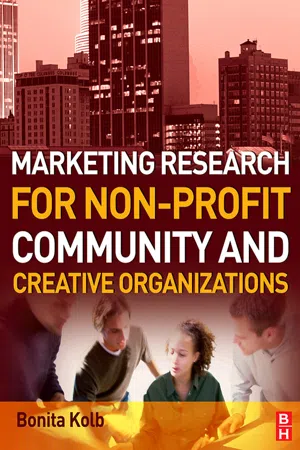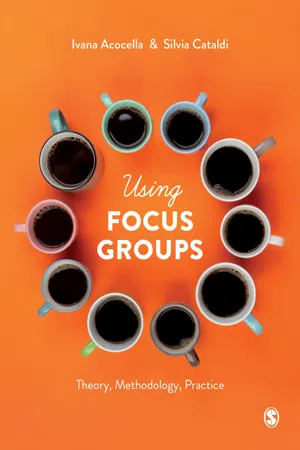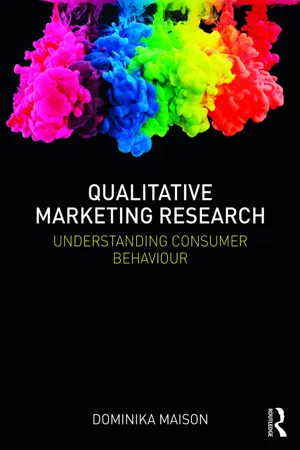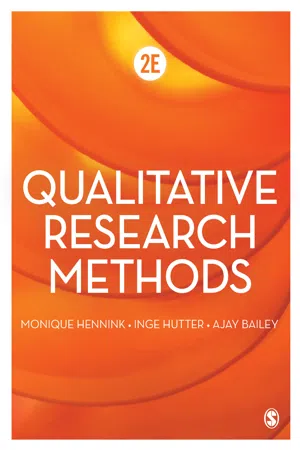Psychology
Focus Groups in Qualitative Research
Focus groups in qualitative research involve gathering a small group of participants to discuss a specific topic in depth. This method allows researchers to explore diverse perspectives, attitudes, and experiences related to the topic. By facilitating group interaction, focus groups can generate rich, nuanced data that can provide valuable insights into psychological phenomena.
Written by Perlego with AI-assistance
Related key terms
Related key terms
1 of 4
Related key terms
1 of 3
10 Key excerpts on "Focus Groups in Qualitative Research"
- eBook - ePub
- Louise Hardwick, Aidan Worsley(Authors)
- 2010(Publication Date)
- SAGE Publications Ltd(Publisher)
6FOCUS GROUPS
OVERVIEW
Focus groups have been described in a number of ways by people who see them from quite different perspectives, most noticeably contrasted in their uses within market research and social science research. Kitzinger, from the latter approach, describes focus groups as ‘a form of group interview that capitalises on communication between research participants in order to generate data’ (1995: 299). It is important here to note that a distinction is made between a group interview – which, while broadly the same, is perhaps best differentiated as a concurrent sequence of interviews with individuals in a group – and the focus group – which involves much more emphasis upon the group experience, the interaction between the participants and, as noted, the communication between members of the group. Within the realm of market research one finds an emphasis being placed upon attitudes within the group towards products, services, advertising and the like. Of course, these notions are increasingly finding a place within social work with the development of the service user/carer as consumer. Powell and Single deploy the following definition of focus groups which neatly captures the purposeful assembling of focus groups for research that lifts them out from our more usual concept of a ‘group’:A group of individuals selected and assembled by researchers to discuss and comment on, from personal experience, the topic that is the subject of the research. (Powell & Single, 1996: 499)Given their simplicity, focus groups are a surprisingly under-used method of social research in relative terms. They seldom get a chapter to themselves in the literature of research methodology, perhaps because of their background in market research, and have only relatively recently made inroads into the broader arena of social research (Bryman, 2008). In many ways focus groups are a particularly appropriate method to consider in social work research, being one of the least directive and most empowering forms of data gathering – and therefore broadly in tune with social work values. Furthermore, the practitioner researcher, as a moderator of a focus group, would need to draw on a range of knowledge, skills and sensitivities that typically one could expect social workers (either qualified, or in the process of qualifying) to possess in abundance. Indeed, it may well be that the poor regard held by focus groups in some areas of research literature is due to the relative inadequacies of moderators who don’t posses sufficient skills in this area and find them hard to manage well. We would argue that focus groups ought to form part of more research activity in the social work area for all these reasons. Yet, having said that, the use of focus groups as a research method has expanded considerably in recent years and we are now seeing their use across a broad range of social situations, including education, sociology, health, organisations, evaluation, politics, psychotherapy and, of course, marketing (Stewart et al., 2007). - eBook - ePub
Market Research in Practice
An Introduction to Gaining Greater Market Insight
- Paul Hague(Author)
- 2021(Publication Date)
- Kogan Page(Publisher)
06Focus groups
The focus group
The focus group is a research tool used to collect data through group interaction on a topic. Essentially, it is a group experience comprising a small number of carefully selected people who are recruited to discuss a subject on the basis of their shared experience.Focus groups have four key characteristics:- They actively involve people.
- The people attending the group have an experience or interest in common.
- They provide in-depth qualitative data.
- The discussion is focused to help us understand what is going on.
Focus groups have traditionally taken place in a face-to-face environment, with all participants brought together in one location for a given period of time to discuss the research topic. However, technological advances have made it possible to bring groups together online, overcoming the barrier of participant proximity to the focus group venue. Online groups tend to adopt one of two styles: the ‘live chat’ forum or the ‘bulletin board’ group, which tends to remain open and live for several days but does not require participants to be logged in during the whole period.The people that make up a focus group
Focus groups typically are made up of five to 10 people. The group needs to be small enough to allow everyone the opportunity to share insights, and yet large enough to provide group interaction and diversity of experience. Larger face-to-face groups inhibit discussion, as some delegates shy away from venturing opinions, while smaller groups may be limited in their pool of ideas. Bulletin style online groups afford the opportunity for a larger number of participants.Commonality of experience and interest
Focus group participants have a degree of homogeneity, and this is important to the researcher. This similarity is the basis for recruitment, and indeed, specific requirements are usually necessary for attendance at the group. - eBook - ePub
- Andrew Whittaker(Author)
- 2012(Publication Date)
- Learning Matters(Publisher)
Focus groups have entered the popular imagination following their controversial use in the early years of the New Labour Government (Barbour and Kitzinger, 1999). Although group interviews have a long history in market research and were used to evaluate propaganda during the Second World War, it is only relatively recently that focus groups have become a popular and respected research method in the social sciences (Morgan, 1997).Focus groups are versatile and have been used for a wide range of topics. For example, focus groups have been used to research infertility in British South Asian communities (Culley, et al., 2007), children’s experiences of mental health services (Day, et al., 2006), women’s health in rural India (Vissandjée, et al., 2002), female genital mutilation in Switzerland (Thierfelder, et al., 2005), and access to out-of-hours health services by members of the Vietnamese community in London (Free, et al., 1999).Defining focus groups
A focus group is a group of individuals selected to provide their opinions on a defined subject, facilitated by a moderator who aims to create an open and relaxed environment and promote interaction between participants. Rather than an interview with a number of participants giving their views, focus groups enable discussion between participants (Kitzinger, 1994). Such discussions can enable participants to explore and challenge each other’s views and can result in people clarifying and changing their views.Combining focus groups with other research methods
Focus groups are often used on their own, but can be combined with other research methods such as surveys or interviews (Morgan, 1993, 1997). Focus groups can be used before a survey to provide an overview and test the range of opinions which will be used in questionnaire construction. For example, the Scottish Executive used focus groups to develop a national survey for people from minority ethnic communities (Scottish Executive, 2003).Interviews can be used in conjunction with focus groups where participants may disclose more sensitive information than they would in a group setting. While focus groups are effective in accessing shared, public knowledge, interviews are fruitful for more personal, biographical information. For research topics that require both forms of knowledge, combining both methods can be productive. - eBook - ePub
Using Research Instruments
A Guide for Researchers
- Peter Birmingham, David Wilkinson(Authors)
- 2003(Publication Date)
- Routledge(Publisher)
(Anderson 1996: 200)A focus group is a carefully planned and moderated informal discussion where one person’s ideas bounce off another’s creating a chain reaction of informative dialogue. Its purpose is to address a specific topic, in depth, in a comfortable environment to elicit a wide range of opinions, attitudes, feelings or perceptions from a group of individuals who share some common experience relative to the dimension under study. The product of a focus group is a unique form of qualitative information which brings understanding about how people react to an experience or product.Focus-group interviews have enjoyed consistent popularity over many years as an effective and economical instrument of data collection. If you have an interest in market research you will no doubt be aware of the dominance of the focus group within that field, having been utilised for decades to evaluate consumers’ opinions of products and services ranging from new cars to washing powders, television programmes to customer help-lines (Greenbaum 1998). The information they produce has been used to develop better products and to encourage consumers to use or buy them. This original commercial focus has gradually widened to include consumers of education, health and community programmes and services, such as the extent of parents’ support for new school facilities, patients’ levels of satisfaction with their treatment at their local hospital, pensioners’ thoughts on the quality of their local civic amenities, and so on. Political parties are the latest in a long line of clients of focus-group consultancies, keen to gather public opinion of their prospective parliamentary candidates and MPs, and what they stand for, with a view to maximising their appeal (Diamond and Bates 1992).During the 1980s market researchers were joined in their use of focus groups by social science researchers. They realised that the ways in which focus group interviews are organised–in particular the relaxed and convivial setting, the unrestricted nature of the discussion, and the neutrality of the moderator–meant they were particularly suited to collecting data on sensitive, delicate and otherwise complex or difficult social issues. Research on domestic violence, mental health and sexual behaviour (particularly in relation to HIV/AIDS and contraception), for example, has increasingly utilised focus groups in the data-collection phase (Richter et al - eBook - ePub
Qualitative Organizational Research
Core Methods and Current Challenges
- Gillian Symon, Catherine Cassell, Gillian Symon, Catherine Cassell(Authors)
- 2012(Publication Date)
- SAGE Publications Ltd(Publisher)
15 Focus GroupsBinna KandolaIntroduction
The use of focus groups in the social sciences waxes and wanes depending on the prevailing attitude towards them and the popularity of alternative approaches. Although the last 20 years have seen an increase in their use for research purposes, they have been used as a research tool for nearly a century. Stewart et al. (2007) identify three influences on focus group methodology:- Sociology and social psychology.
- Clinical psychology.
- Market research.
Researchers with a sociology or social psychology background tended to use the method to gain insights into group-related topics such as social interaction and cohesion. These applications broadened out in the 1940s with the advent of radio. Broadcasters and researchers were interested in finding out why some programmes were more popular than others. Technology was created that enabled group participants to press buttons while listening to a programme indicating whether they liked or disliked something. Modern versions of these devices are still in use today. There was, in other words, a focus on the research, as all data were obtained from groups of people. The clinical psychology approach was less direct, preferring people to discuss whatever it was they wanted to give expression to. This type of approach was more influenced by psychotherapy and facilitators tended to have a psycho-therapeutic background. Market researchers, however, tended to be less concerned about the theoretical background and would use whatever technique and methodology they felt was appropriate. This might sometimes be less rigorous but it shows us that the focus group is a versatile and adaptable method, which can be fun as well as informative. Following these traditions, the roots of focus groups can be traced back to the early twentieth century.However, if you look beyond the social sciences to other disciplines you will find methods that appear remarkably like focus groups but are called something else. In design, architecture and engineering circles there is a technique called the charette. This enables stakeholders to have their say in, for example, the design of a building. This approach has its roots in the nineteenth century and possibly earlier. So focus groups, or other variations, have a long history. - Bonita Kolb(Author)
- 2008(Publication Date)
- Routledge(Publisher)
Focus groups are considered exploratory research because an issue or problem is being explored. For this reason focus groups are often one of the first choices of research methodology when little is known about the cause of a problem. Once focus groups have been used as a first step in exploring an issue, the findings can be confirmed using a quantitative research technique such as a survey. Focus groups are sometimes misunderstood as mere discussion groups where people just talk while a moderator listens. However, a well designed focus group conducted by a trained moderator is much more. The purpose of a focus group is to encourage participants to go beyond their first response to the issue being discussed. Interaction with the moderator and also between the group members is designed to uncover deeper insights which can be used to develop new and creative ideas for the marketing mix. In addition, these insights can then be communicated to groups within the organization to build the case for support of the marketing programme (Hanson, 2001). Focus groups do not start with a hypothesis about the cause of a problem. Instead they are used to generate new ideas for the organization. In addition they can be used to explore reasons for an organization’s problems or failures. In a focus group ideas for a new consumer segment to target, new ways of packaging a product and more effective promotion can be generated. Purposes of conducting focus groups Exploring the cause of a problem or issue New market segments to target Enhancing the product to increase its appeal Developing effective promotional campaigns Exploring problems: When an organization has a problem, it is tempting to try to solve the issue internally. However, the employees of the organization can only see the problem from their own viewpoint. While these insights are important it is extremely helpful to get the opinions of current or potential consumers as to the cause of the problem- Graham R. Williamson, Andrew Whittaker(Authors)
- 2019(Publication Date)
- Learning Matters(Publisher)
Interviews are one of the most popular qualitative research methods for nursing researchers and students and feel intuitively ‘familiar’ because of their use in everyday nursing practice. They are popular in the social sciences generally and are used in the majority of published qualitative research articles (Silverman, 2017). Many research studies use individual interviews to collect data, but focus groups are becoming increasingly popular, and rely on group dynamics to produce data on particular topic areas. They are a form of interview, albeit one with a small group discussing ideas with a facilitator. Interviews and focus groups are examples of qualitative study designs. Broadly speaking, qualitative designs seek to understand and interpret the thoughts, feelings, behaviour, actions and cultures of individuals and groups. Their ‘tools’ are questioning, talking and analyses of texts, not numerical data (as would be present in a quantitative study design).In this chapter, you will be asked to consider the advantages and disadvantages of these techniques and when it would be most appropriate to use them. Practical issues raised by their use will be emphasised through case studies and student-centred activities.Interviews
The interest in interviews is not confined to nursing research. Scourfield (2001) argues that we live in an ‘interview culture’, in which we are constantly exposed to the idea that something valuable can be learnt by talking one to one with another person. Interviews are intuitively ‘human’, a face-to-face interaction that enables you to communicate with your participants in depth and offers the opportunity to follow up interesting responses. Interviews can enable people to tell their story and are particularly attractive when researchers want to explore people or communities that have traditionally been ignored, misrepresented or suppressed.When should interviews be used?
Interviews are best used for research that focusses on the knowledge, values, beliefs and attitudes of participants. They are particularly good at helping participants to think through, consider and make explicit things that have previously been implicit. Robson (2016) argues that facts and behaviour are more easily obtained than beliefs and attitudes, though participants may experience memory lapses or bias so specific questions about things in the present or recent past are best. Questions about a participant’s beliefs and attitudes are more complex because responses may be affected by the wording and sequence of questions, but the use of multiple questions and scales can help.- eBook - ePub
Using Focus Groups
Theory, Methodology, Practice
- Ivana Acocella, Silvia Cataldi(Authors)
- 2020(Publication Date)
- SAGE Publications Ltd(Publisher)
Considering these four different functions is fundamental for drawing up a good focus group design. Indeed, each function corresponds to a different cognitive goal and, thus, to different choices in collection planning.In this chapter, after briefly analysing the elements of qualitative research design, we examine how these elements can be appropriately applied in the four different functions of the focus group. In detail, the chapter describes the main characteristics of research in which the focus group is used in an autonomous information-gathering role.Chapter goals
- Knowledge: focus group research design when it is decided to use the technique in an autonomous information-gathering role.
- Applying knowledge and understanding: how to design a focus group on the basis of its different functions with reference to the composition of the groups and the structuring level of the information collection tools.
- Making judgements: developing a critical analysis on the possibility to conduct neutral observation and obtain immediate empirical knowledge.
3.1 The characteristics of a focus group research design
As presented in the first chapters, the focus group is an effective technique when a researcher is interested in bringing out the socially shared knowledge or collective representations disseminated in particular social groups. Indeed, the focus group is a group discussion held for research purposes that involves people who belong to a social category identifying their membership of a particular community (citizens, politicians, women, young people, social workers, etc.). The collective discussion can favour the emergence of intersubjective representations, reproducing widespread images and shared beliefs within the social group that focus group participants are required to represent (representations of citizens, politicians, women, young people, social workers, etc.).Specific features
In order to choose how to conduct a research with focus group, it is important to outline the general characteristics of a research design using this technique. The expression ‘research design’ refers to a general strategy that integrates the various components of the study in a coherent and logical way, thus ensuring an appropriate study of the research topic. - eBook - ePub
Qualitative Marketing Research
Understanding Consumer Behaviour
- Dominika Maison(Author)
- 2018(Publication Date)
- Routledge(Publisher)
3 Qualitative methods The different tools in the hands of a marketing researcher Classic qualitative marketing research methods: focus group interviews and individual in-depth interviewsFocus group interviews (FGIs), also called focus group discussions (FGDs), are the most commonly commissioned type of qualitative research in marketing (Belk, Fischer, & Kozinets, 2013; ESOMAR, 2016; Greenbaum, 1993). The greater number of group discussions compared to individual interviews in the marketing context is mainly down to fashion (being considered more spectacular) and convenience (shorter performance times, ease of interview observation by clients), not actual methodological premises. From methodological point of view both methods are essentially very similar and can often be used interchangeably. This doesn’t mean that both methods are identical as certain differences do exist between them, thus, when deciding whether a group or individual interview is more suitable, we must be aware of the consequences of using each of these methods (see Table 3.1 ).A focus group interview is a discussion between several people, usually about six to eight, led by an interviewer, called a moderator. The moderator’s task is to guide (focus) the interview appropriately in order to find out as much as possible about the research subject (Cowley, 2000). This approach has four characteristic elements: (a) it is carried out in a group setting (several participants), (b) it is focused around (concentrates on) a specific topic, (c) the conversation is in-depth (not superficial), and (d) it is in the form of a discussion, not just a question and answer session. Its theoretical basis is two main fields of knowledge: (a) qualitative research methods (individual in-depth interviews, observations, and projective techniques), (b) social psychology – knowledge on small groups, their dynamics, and group processes (drawing from what is known about therapeutic groups, support groups, and interpersonal training). - eBook - ePub
- Monique Hennink, Inge Hutter, Ajay Bailey(Authors)
- 2020(Publication Date)
- SAGE Publications Ltd(Publisher)
non-directive interviewing where the purpose is to move away from interviewer-dominated data collection towards promoting a more spontaneous discussion between participants that replicates everyday social interactions. The ‘hallmark of focus groups is their explicit use of group interaction to produce data and insights that would be less accessible without the interaction found in a group’ (Morgan, 1997: 2). Group interaction is beneficial for two main reasons. First, an interactive discussion allows participants greater control over the issues raised compared to responding directly to questions from an interviewer. Participants are essentially probing each other when they enter into a discussion, by asking others for more detail, explanation or justification about an issue raised. This is extremely beneficial for the research as it is more likely to uncover unexpected issues, provide a deeper understanding of the issues and produce richer data as a result. Furthermore, probes from another participant are often more natural than a question from the moderator. The second benefit, and perhaps the more important, is that an interactive discussion between participants can ‘reach parts that other methods cannot reach – revealing dimensions of understanding that often remain untapped by the more conventional one-to-one interview or questionnaire’ (Kitzinger, 1994: 107). A dynamic discussion can lead to participants agreeing with one another, which provides you with confirming data about the issue, or they may disagree with one another and the ensuing dialogue involves each participant outlining their differing perspectives. This provides you with nuances of the varying perspectives that are not accessible in any other type of interview format. Therefore, an interactive discussion (with little moderator involvement) can lead to unanticipated issues and perspectives arising spontaneously. This is where focus group discussions provide a unique approach to collecting qualitative data.Promoting a discussion between group members is a vital element of any focus group, but it is mistaken to believe that this task is left only to the moderator. Although the moderator’s role is critical, all elements of the study design contribute to enabling a discussion and make the moderator’s role easier. Enabling discussion begins with selecting a research topic that is suitable for a group discussion; managing group composition so that participants feel confident to discuss issues; developing a discussion guide with questions phrased to foster discussion; holding the discussion in a location that makes participants feel comfortable; and seating participants in a circle to foster interaction. All these design elements make small but important contributions to enabling a discussion in addition to the skills of the moderator. Therefore, if a group discussion fails, all elements of the study design need to be reviewed – not only the role of the moderator. Below we describe techniques that can be used by the moderator to foster an effective discussion that yields information useful to the research objectives. These techniques include the moderation style,active listening, probing, using activities to stimulate discussion and avoiding thedeference effect
Index pages curate the most relevant extracts from our library of academic textbooks. They’ve been created using an in-house natural language model (NLM), each adding context and meaning to key research topics.
Explore more topic indexes
Explore more topic indexes
1 of 6
Explore more topic indexes
1 of 4









